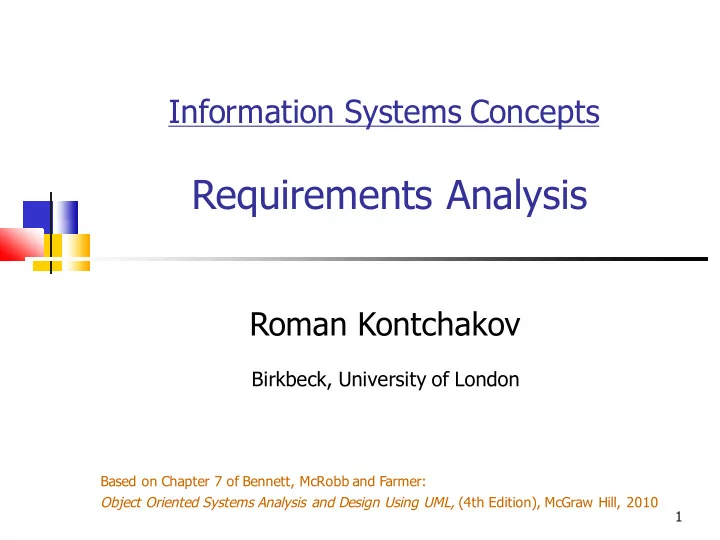

Information Systems Concepts Requirements Analysis Roman Kontchakov Birkbeck, University of London Based on Chapter 7 of Bennett, McRobb and Farmer: Object Oriented Systems Analysis and Design Using UML, (4th Edition), McGraw Hill, 2010 1
Outline n Class Diagrams n Section 7.3 (pp. 184 – 194) n Section 7.5.5 – 7.5.10 (pp. 208 – 215) n Section 7.5.2 (pp. 198 – 201) 2
Class Diagrams n Class (and Object/Instance) n Stereotypes n Attributes (and State) n Associations (and Links) n Multiplicity n Operations Symbols of Instances, States, and Links are used in other UML diagram types (Object Diagrams, Communication Diagrams, etc.) 3
Notation: Class Client class name compartment companyAddress companyEmail companyFax attributes compartment companyName companyTelephone operations compartment 4
Notation: Object/Instance object name FoodCo:Client compartment companyAddress=Evans Farm, Norfolk companyEmail=mail@foodco.com attribute values companyFax=01589-008636 companyName=FoodCo companyTelephone=01589-008638 instances do not have operations 5
Attributes n Attributes are: n part of the essential description of a class n the common structure of what all objects of the class can ‘know’ n each object has its own value for each attribute of its class n attribute values characterize state of the object 6
Notation: Attributes Campaign actualCost campaignFinishDate campaignStartDate completionDate datePaid estimatedCost title checkCampaignBudget ( ) getCampaignContribution ( ) recordPayment ( ) setCompleted ( ) 7
Links Yellow Partridge:Client a link is a logical connection between two objects FoodCo:Client Grace Chia:StaffMember Carlos Moncada:StaffMember Soong Motor Co:Client 8
Associations n An associations represent the possibility of a logical relationship or connection between objects of one class and objects of another n If two objects can be linked, their classes have an association 9
Notation: Associations association association role Client StaffMember companyAddress staffContact staffName companyEmail staffNo liaises with companyFax staffStartDate companyName companyTelephone association name direction in which name should be read 10
Notation: Associations association role StaffGrade previous gradeStartDate gradeFinishDate following
Multiplicity n The multiplicity of an association is the range of permitted cardinalities of its participating objects, according to or business rules. n for example: n any bank customer may have one or more accounts n every individual account is for one, and only one, customer 12
Notation: Multiplicity n n : exactly n n * : any number n m .. n : any number in the range m to n (inclusive) n 0..1 : optional (i.e., either none or 1) n 1.. *: at least one 13
Notation: Multiplicity multiplicities Client StaffMember companyAddress 1 0..* companyEmail staffName companyFax staffNo liaises with companyName staffStartDate companyTelephone A staff member may liaise with any number of clients (including 0) Each client is liaised with exactly one staff member See Also: Figure 7.9-7.11 (p. 191) 14
Operations n Operations are: n part of the essential description of a class n the common behaviour that all objects of the class can ‘do’ n get or set attribute values (not specified in Analysis Model) n perform calculations n send messages to other objects n create or destroy links (not specified in Analysis Model) n services that objects of a class can provide to other objects 15
Notation: Operations Campaign actualCost campaignFinishDate campaignStartDate completionDate datePaid estimatedCost title checkCampaignBudget ( ) getCampaignContribution ( ) recordPayment ( ) setCompleted ( ) 16
Static Analysis with UML n Requirements Model → Analysis Model → Design Model n To Draw an Analysis Class Diagram n Identify Classes n Determine Stereotypes n Find and Locate Attributes n Add Associations n Determine Multiplicity n Find and Locate Operations 17
Looking for Potential Classes Category Examples People Mr Harmsworth (a campaign manager), Dilip (a copywriter). Organisations Jones & Co (a forklift truck distributor), the Soong Motor Company, Agate’s Creative Department. Structures Team, project, campaign, assembly. Physical things Fork-lift truck, electric drill, tube of toothpaste. Abstractions of people Employee, supervisor, customer, client. Abstractions of physical Wheeled vehicle, hand tool, retail goods. things Conceptual things Campaign, employee, rule, team, project, customer, qualification. Enduring relationships Sale, purchase, contract, campaign, agreement, assembly, between members of employment. other categories. 18
Identifying Classes n Should this really be considered as a class? n Is it beyond the scope of the system? n Does it refer to the system as a whole? n Does it duplicate another class? n Is it too vague? n Is it too specific? n Is it too tied up with physical inputs and outputs? n Is it really an attribute? n Is it really an operation? n Is it really an association? If any answer is ‘Yes’, consider modelling the potential class in some other way (or do not model it at all). 19
Take Home Messages n Class Diagrams n Class (and Object/Instance) n Attributes (and State) n Associations (and Links) n Multiplicity n Operations 20
Recommend
More recommend